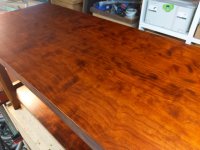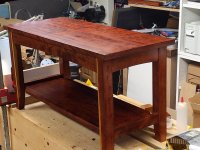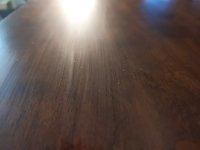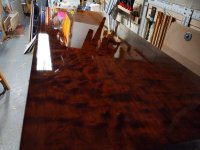I'm making a bench out of cherry, with a curly cherry top. After about 40 finish samples, I locked down a process that gets the color needed.
High level, the process is waterborne dye, 2 thin coats of shellac to lock it in, and about 4-6 coats Arm R Seal satin. Dying cherry seems to go better after sanding to 400g.
From some angles, it looks alright:
View attachment 1
View attachment 2
But from a sideways view or at a low reflected light, there are many visible streaks in the finish.
View attachment 3
View attachment 4
The first two coats of Arm R Seal, I laid it on pretty heavily and let it soak for about 8-10 minutes before wiping it off. By the second coat, I was noticing streaks. The next two I applied with a shop towel. After this, I waited 2 days and did some block sanding with 600g paper. This showed a lot of high/low spots.
I've never had a problem with Arm R Seal in the past - having used it for a number of tables, trimwork, frames, etc.. Not sure why I'm running into an issue here or what the root cause might be. Does anyone know what might be happening?
High level, the process is waterborne dye, 2 thin coats of shellac to lock it in, and about 4-6 coats Arm R Seal satin. Dying cherry seems to go better after sanding to 400g.
From some angles, it looks alright:
View attachment 1
View attachment 2
But from a sideways view or at a low reflected light, there are many visible streaks in the finish.
View attachment 3
View attachment 4
The first two coats of Arm R Seal, I laid it on pretty heavily and let it soak for about 8-10 minutes before wiping it off. By the second coat, I was noticing streaks. The next two I applied with a shop towel. After this, I waited 2 days and did some block sanding with 600g paper. This showed a lot of high/low spots.
I've never had a problem with Arm R Seal in the past - having used it for a number of tables, trimwork, frames, etc.. Not sure why I'm running into an issue here or what the root cause might be. Does anyone know what might be happening?






